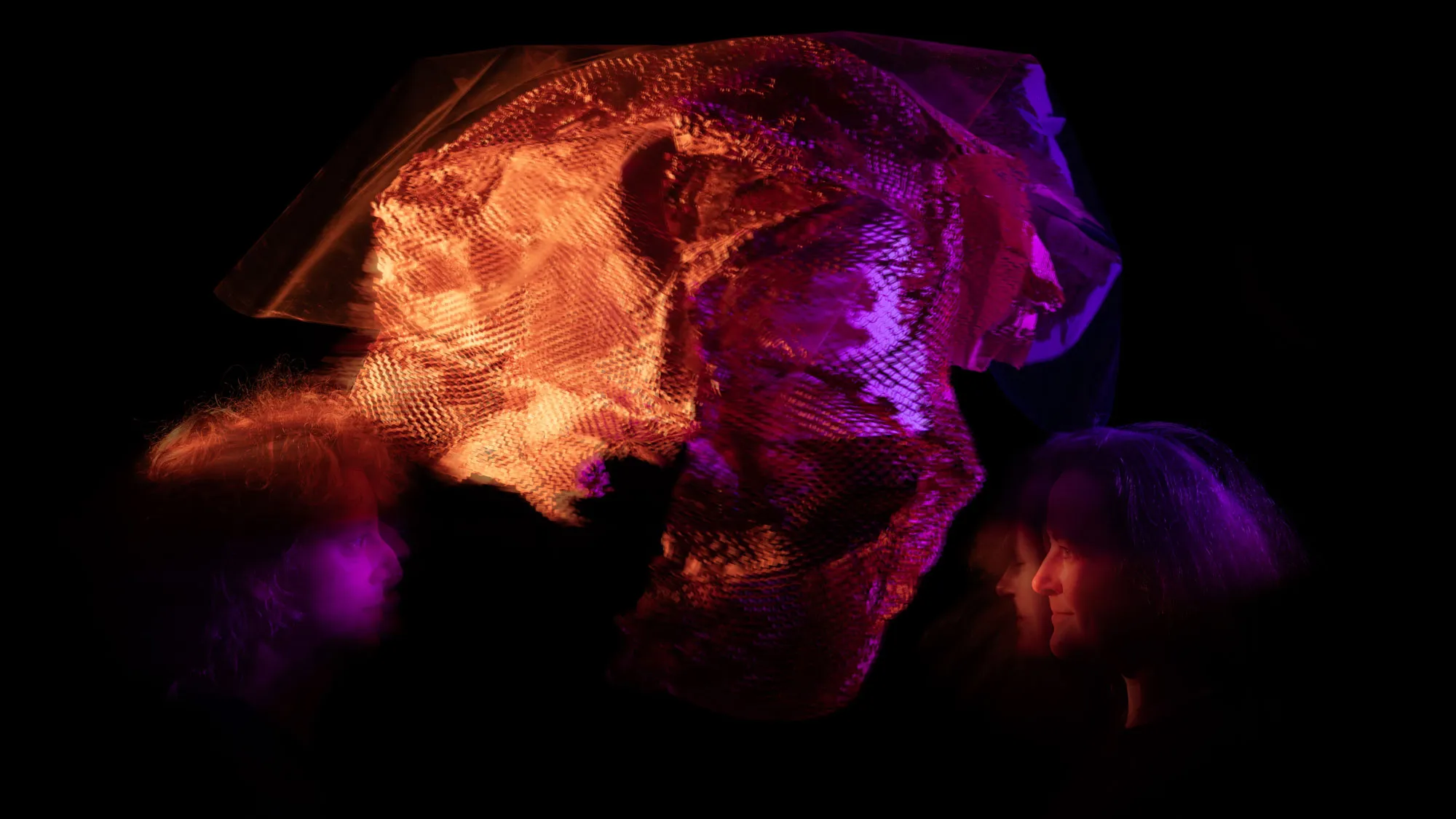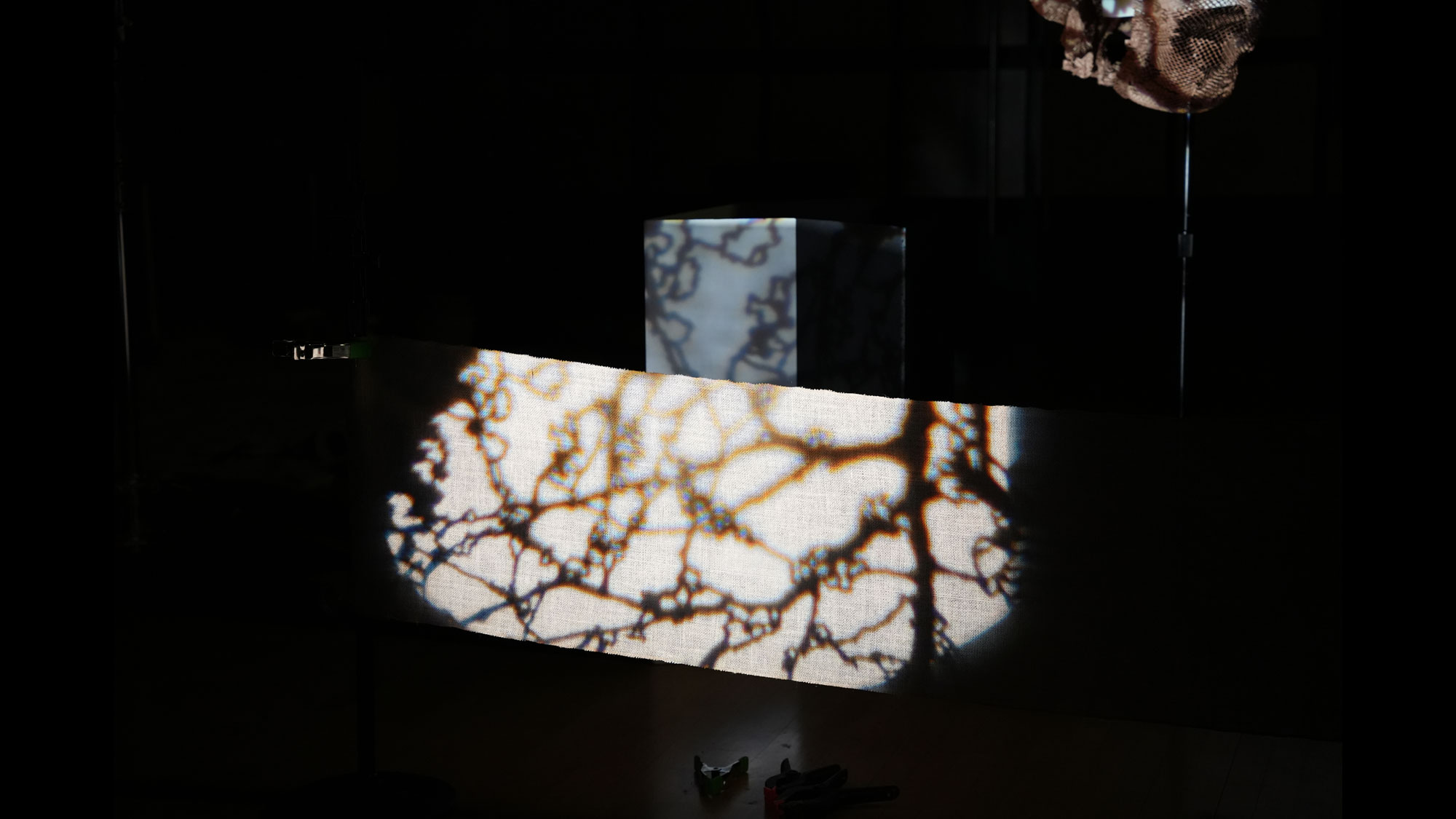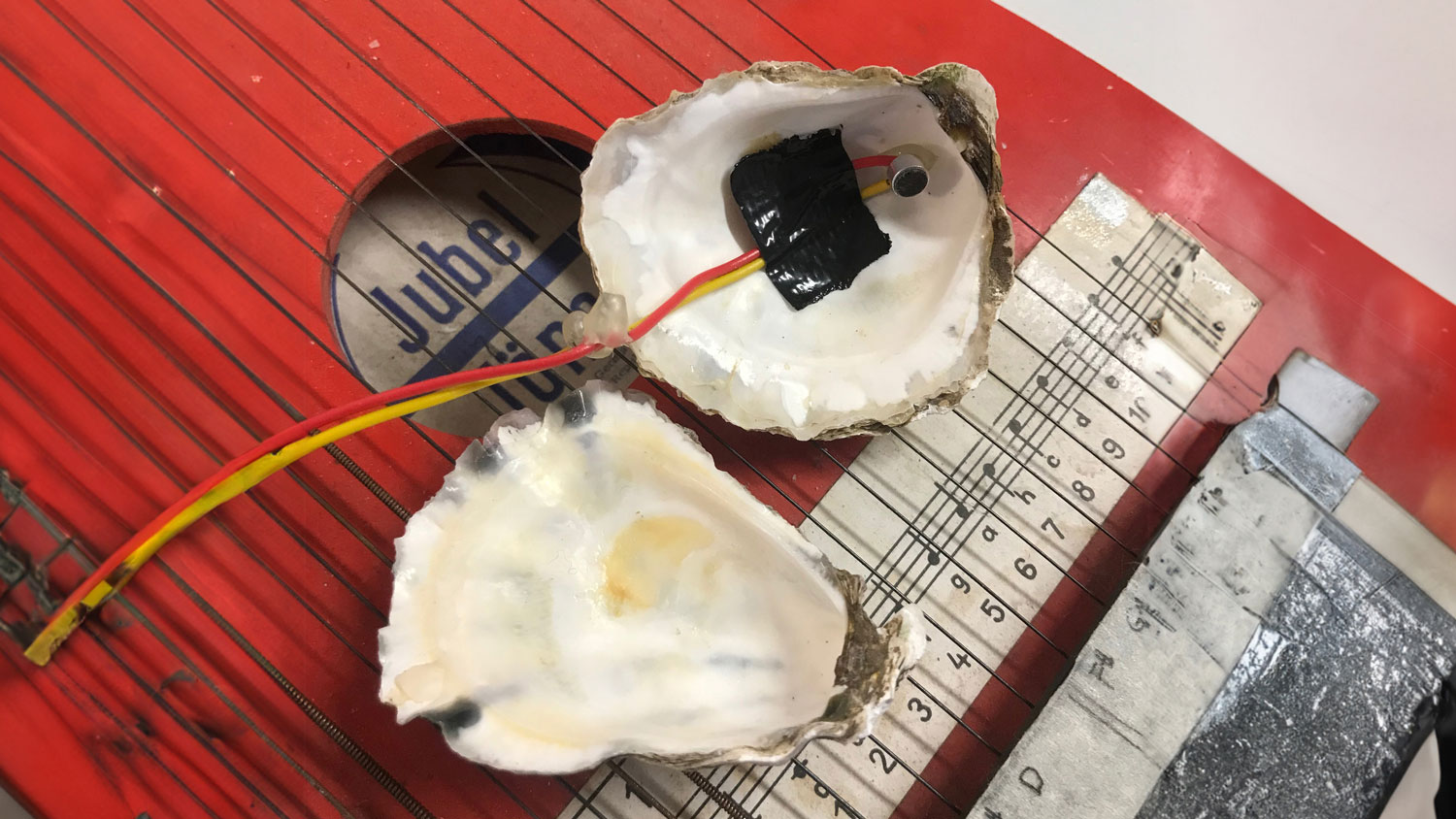
Susceptible Chambers
If music can be thought of as meaningful time, then Antonia and Jessie's literal musical playground also creates a meaningful space.
—Curator Amadeus Julian Regucera, from “The Discipline of Play”
Composer-performers Antonia Barnett-McIntosh and Jessie Marino’s Susceptible Chambers is an EMPAC-commissioned performance, which draws lines between the worlds of sound art, handcrafts, and experimental theater. It begins with the re-construction of a simple microphone.
Musicians have historically augmented familiar musical instruments with alternative materials to change their, and the audience’s, relationship to that object from a sonic and cultural standpoint. By designing and building specially-crafted objects, and experimenting with instrumental expansion, we can hear these materials interacting with one another—and experience the possibilities of a completely new sonic landscape, which can be discovered by playing with (a) particular combination/s of materials.
Developed during a series of residencies, Antonia and Jessie have laid the groundwork for an audio-visual performance that is both whimsical and rigorously executed. Composed from manifold permutations of “extended” microphones, the composer-performers experiment with different microphone filters and casings as well as speakers, light, and color arrangements.
Susceptible Chambers collects technologies from bygone eras—pulley systems, pianolas, needlepoint, sodium vapor lamps—and places them in conversation with bespoke, handmade and electronic objects. Antonia and Jessie's newest production draws the audience into an unusual, idiosyncratic, and playful sonic and visual world, experimenting with and challenging generally accepted practices of today’s electronic music, and contemporary music more broadly.
Main Image: Production process image: Susceptible Chambers, 2023. Created during the artists residency in August, 2023 in Studio 2. Courtesy the artists.
The Discipline of Play
It’s difficult to write about an artwork that’s still in progress, particularly one which will result in performance. You can see and hear all the pieces in play so far—lights and video, sound, objects—but what you cannot see are the manifold ways that all these moving parts will relate, combine, or conflict to create unpredictable performative situations and possibilities.
Antonia Barnett-McIntosh and Jessie Marino’s Susceptible Chambers, my first commissioned project as music curator at EMPAC, began as a proposal with the burgeoning capacity for expansion beyond merely sound. Their Expanded Microphone Project would take simple condenser microphones and retrofit their filter casings based on the shapes of various nonstandard organic and artificial objects. Susceptible Chambers is a reference to and inversion of Alvin Lucier’s 1968 work Chambers in which recordings are placed inside everyday objects such as teapots and cigar boxes whose resonant frequency then filters the sound of the playback recordings. Unlike Lucier’s chambers, Antonia and Jessie’s are subject to manipulation by performers; in Antonia’s words, “We liked [Susceptible] literally/physically and conceptually.. as in open to fragility, variability, breakability, flexibility.” Here was a compositional concept in which experimentation was innate.
Through a series of conversations, residencies, and trials, the duo’s project began to take form in EMPAC Studio 1—Goodman as a whimsical playground. Strung-up on an array of transversal pulley systems, multicolored papier-mâché and ceramic thingamajigs populate the three-dimensional space like an arts-and-crafts explosion. Striking lighting design and kaleidoscopic projections animate the mise-en-scène, less a Broadway production than an elementary school pageant. But for all its DIY bricolage, we can no doubt recognize their fantastical virtuosity of imagination and excitedly anticipate what strange sights and sounds would emanate from this menagerie.
In Antonia and Jessie’s world, moving lines of rope intersect in space; doodads exist in fluctuating relation to one another; and hues of colors fade in and out to reveal the world’s variegated textures and remarkable visual tactility.
The music, still in development at the time of this writing, will be activated by the duo’s bespoke microphones. The resultant grain of which will perhaps be predictably intimate, befitting the makeshift visual tapestry and providing a seductive sonic register as a counterpoint to Susceptible Chambers’s bold visual impression.
In all this development, in the process of creating the work, in the residencies and collaborative meetings and conversations, there is something playful about Antonia and Jessie’s enterprise. Indeed, one of the main reasons I was interested in bringing them and their work to EMPAC was that the musical craft, rigor, and technique of their work shunted the self-seriousness that proliferates contemporary Western concert music (admittedly, this is the tradition that they both come from). As Jessie once implored to me, “composing should be fun!” And the attendant process of having fun can only be described as play. Here, then, is the location of craft, technique, and discipline in Susceptible Chambers.
Within the tradition of Western music performance, the nature of musician training, both in practice and in theory, orients itself towards an end. For many teachers and students, this end, achieved by a significant level of discipline, is marked by several hallmarks: fluency, virtuosity, an unbreakable confidence between musician and material (that is, technique, repertoire, performative presence). We can see this philosophy in an often-brutal conservatory pedagogy and even before music school, in the entrainment of young children which conforms to a homogenous standard of musicking. But in the very beginning, from the very pluck of a piano key, the first strum of a guitar, the first strike of a drum, we play music. One doesn’t work at music at the start. No, the work comes later, as if we as musicians outgrow this initial phase, either in childhood or in continued training, by shedding a nascent identity. It is not an identity based necessarily on naiveté or ignorance; rather, it is one of wonder and investigation.
By then returning to play, an advanced musician (by Western standards) brings with them the experience and worldliness of practical rigor and critical perspective. So one does not return to play but becomes someone else, a person who resembles a child and possesses a child-like relationship to music. Therefore, play is the process by which a trained musician becomes a child.1 Play is the process by which the static identity of [trained] musician is subsumed by the dynamic of becoming a subject more closely resembling a child (for example, in her capacity for learning and discovery). Play isn’t exclusive to children, but socially, it remains their prerogative and purview. Just as children who play with blocks learn about space by building, smashing, and throwing, children who play music learn about time and how musical form can make time meaningful.2 Antonia and Jessie’s play is inherently socially deviant, insofar as their flouting of received conventions are delinquent; they defy the standards, rules, and goal-oriented forms of music-making.3
I say music here to situate this process of becoming a child in relation to a traditional definition of music. After nearly 80 years of post-World War II experimentalism, we are firmly in a post-John Cage musical tradition; music has been emancipated as sound, and composition is simply its organization into formalized structures. Yet, for many, including composer-performers Antonia and Jessie, these structures are not merely sonic abstractions but actual structures in space, or the manipulation of light and video projection, or the amplification of sound through physical movement. The expansion of music composition as a discipline is an act of inclusion, one which recoups play into its experimental repertoire and opens up spaces and bodies, not simply time, into arenas of discovery and of learning.
For Susceptible Chambers, Antonia and Jessie, who have not worked together as artists before this project, are not “learning to perform but performing in order to learn”—about sound, about sound in relation, about each other, about themselves.4 Play is crucial in new collaborative relationships. Antonia and Jessie are building a world, an identity as a duo in real time. As musician and scholar Chris Stover writes in “Affect, Play, and Becoming-Musicking,” “when children play music—when they become-musicking—they enter into proliferating series of relations with other musicking bodies, with musical-
objects-as-bodies, with active and passive lines connecting to virtual pasts and futures.”5 During their performance, Antonia and Jessie not only interact with each other but with the various musical objects onstage as well as with their tradition, their performance practice, personal (musical) upbringings, the audience, etc. It’s through the rigorous compositional structuring of these interactions that we can begin to find discipline in their play.
When creating something new with new people, engaging in play subverts conformity, hierarchy, and re-presentations of normative standards. Antonia and Jessie are playing in order to discover new couplings, new assemblages, and emergent networks of relationality, for instance:
• Antonia’s movement to Jessie’s movement, and vice versa
• a discrete sound to another discrete sound, then the resultant sonic texture to lights, movement, bubbles, objects, etc.
• movement to sound, sound to movement; Antonia’s movement to Jessie’s sound, and vice versa, etc.
• light to sound, and vice versa, etc.
• light to object to object to light, and vice versa, etc. (e.g. jellyfish to bubbles, cone to fake candle)
The fields of intersectionality and relationality are nearly endless, and“performance” can be thought of as the location for these fields to proliferate in real-time.
Ultimately, if music can be thought of as meaningful time, then the literal musical playground Antonia and Jessie have created is a way to discover how music can also be meaningful space. Susceptible Chambers is an invitation. For Antonia and Jessie, it’s an invitation to each other to collaborate and learn. And for us? It’s an invitation to do the same, with the artists as guides, to discover different, perhaps even novel, ways to look at, listen to, and experience music through their wildly fanciful, droll, and exacting vision.
—Amadeus Julian Regucera, Curator Music
1 Here, I would invoke the term becoming from the theoretical work of philosophers Gilles Deleuze and Félix Guattari, appearing first in their 1972 book Anti-Oedipus. Becoming is a fluctuating and dynamic process by which one’s identity is constituted through a continual impingement of intersecting factors. One’s subjectivity is therefore never static but in a state of constant change based on these dynamic factors. For the purposes of this introduction, however, I simplify the term to its original verb usage in order to clarify the results of the process of play more clearly for the reader. 2 Jonathan Kramer, The Time of Music: New Meanings, New Temporalities, New Listening Strategies. (New York: Shirmer, 1988), 1. 3 Chris Stover, “Affect, Play and Becoming-Musicking.” Deleuze and Children. ed. Markus P. J. Bohlmann, Anna Hickey-Moody (Edinburgh: Edinburgh University Press, 2019), 148. 4 ibid. 5 Stover, “Affect, Play and Becoming-Musicking,” 146. What I find interesting here are the visual analogs to multi-temporalities (past, presents, futures) that are at play in Antonia and Jessie’s world: consider the pulley system. In its look/design, refers to older technology rather than the streamlined, invisible rigging technology capable at EMPAC; while this technology’s attendant noise, a timbre preferred by many, including the composers here, speaks to an inclusive post-Cage musical aesthetic (both old and new). Indeed, there are many registers of time in play (so to speak) in Susceptible Chambers.
Dates + Tickets
World Premiere
EMPAC Spring 2024
Press Mention
Season
April 5, 2024
This work was supported by a grant from the Simons Foundation.


